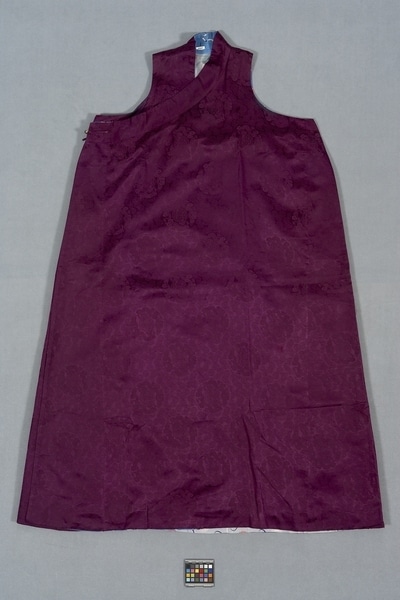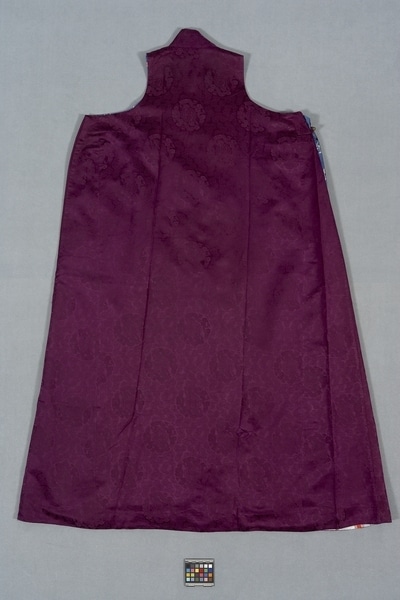Dress Item Number: 1014/1 from the MOA: University of British Columbia


Description
Woman’s long, sleeveless, A-line dress made of purple silk damask that is patterned over-all with small coin-like motifs and larger roundels enclosing images of dragons and an auspicious symbol. The neckline has a high collar that extends diagonally from centre front, across the chest from left to right and fastens under the right armhole with a loop and metal ball-shaped button. The edges are faced with strips of blue silk or rayon crepe that is patterned with black and white ribbon-like streamers and pink, red and green floral motifs. The garment is lined with gray cotton with an over-all printed pattern of red, green, white and dark blue ovoid shapes.
History Of Use
This style of loose-fitting dress is worn as an everyday garment by most females, beginning when they are young children, over a blouse (e.g., 1014/2) and tied at the waist with a sash (e.g., 1014/4). Married women also wear a multicoloured apron (e.g., 1014/3). The collar of the blouse is folded over the collar of the dress. The excess fullness of the dress is carefully folded into pleats in the back and held in place by the sash. This dress is unusual in that it is made of silk, whereas most dresses of this type are cotton or wool. Men also wore a similar type of garment, but most now wear trousers and shirts.
Narrative
Jean Stilwell, the donor, purchased this dress in 1970 or 1971 from a Tibetan woman in Kalimpong, northern India, as part of a total outfit consisting of the dress, a blouse (1014/2), an apron (1014/3) and a simple sash (1014/4). Kalimpong was for many years on the major trade route between India and Tibet and became home to many Tibetan refugees after the Chinese annexation of Tibet. The donor does not know if the dress was made in India, or if it was brought to Kalimpong from Tibet.
Item History
- Made in Tibet ? or India ? before 1971
- Collected in Kalimpong, West Bengal, India between 1970 and 1971
- Owned by Jean Stilwell before January 14, 1985
- Received from Jean Stilwell (Donor) on January 14, 1985
What
- Name
- Dress
- Identification Number
- 1014/1
- Type of Item
- dress
- Material
- silk fibre, dye, metal, cotton fibre and rayon fibre ?
- Overall
- height 149.0 cm, width 89.0 cm
Who
- Culture
- Tibetan
- Previous Owner
- Jean Stilwell
- Received from
- Jean Stilwell (Donor)
Where
- Holding Institution
- MOA: University of British Columbia
- Made in
- Tibet ? or India ?
- Collected in
- Kalimpong, West Bengal, India
When
- Creation Date
- before 1971
- Collection Date
- between 1970 and 1971
- Ownership Date
- before January 14, 1985
- Acquisition Date
- on January 14, 1985
Other
- Item Classes
- textiles
- Condition
- excellent
- Accession Number
- 1014/0001